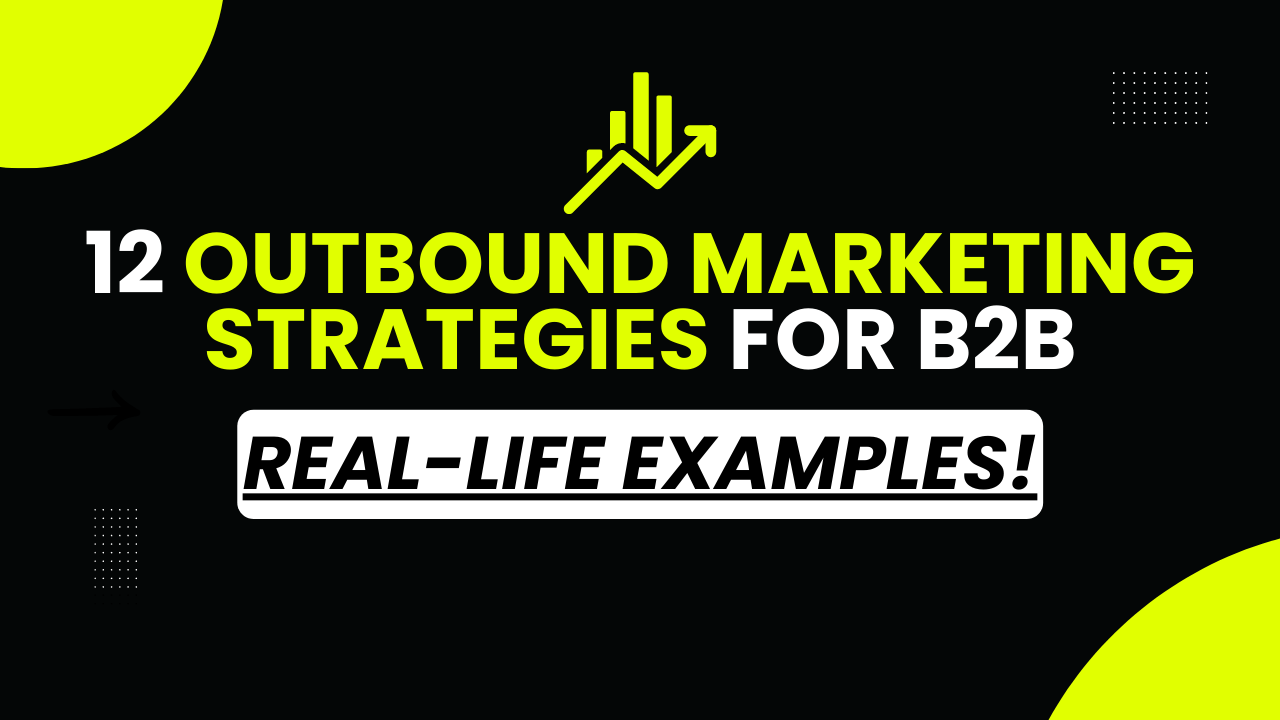12 TOP B2B outbound marketing strategies in 2024.
Summary
In this article, we’ll explore the basics of B2B outbound marketing, highlight the key differences between inbound and outbound marketing, and provide you with 12 B2B outbound marketing strategies with real-life examples.
What is Outbound Marketing Strategy for B2B?
Outbound marketing strategy is the process of proactively reaching out to potential customers through a variety of channels, including cold calling, cold emailing, advertising campaings, etc.
It’s a direct and targeted approach with the aim of quickly closing sales.
A B2B outbound marketing strategy means that salespeople will be contacting other businesses to sell to them, although business-to-consumer outbound strategies exist, too.
Difference between Inbound and Outbound Marketing Strategy for B2B?
While outbound marketing entails proactive, direct outreach to your potential customers, inbound marketing is about attracting customers organically by providing valuable content. Inbound leads will typically come to you through search engines or social media.
Which is better?
Oh, you’re going to need both!
Outbound marketing is great for quickly generating leads and driving sales, but inbound marketing is usually more cost-effective. In fact, the cost per lead generated by inbound marketing is on average 60% less than outbound generated leads.
That being said, inbound marketing takes time: you have to create valuable content to establish trust and authority, work on your SEO so that customers can actually find you, and nurture relationships.
It could take months before your first leads come in and you make sales.
What you want to do is combine both to find that subtle balance between immediate results and sustainable growth.
Today, however, we’ll be looking at B2B outbound marketing strategies to enable those immediate results.
12 Top B2B Outbound Marketing Strategies in 2024
This isn’t one of those articles with overly vague marketing and sales tips.
We’ll share concrete B2B outbound marketing strategies that you can start applying today.
Ready?
Let’s dive in.
Strategy 1: Personalized Cold Email Campaigns
The notorious cold email comes first.
It’s one of the most used mediums for B2B outbound marketing and one of the ones with the highest ROI.
And you’ve probably already sent some.
Just in case: a cold email is an unsolicited email sent to a prospective customer with no previous relationship.
The more targeted this email is, the better.
Sure, you could blast the email to all the email addresses you have, but you should expect low conversion and open rates, a high bounce rate, and you’re risking being flagged as spam by your email provider, hurting your deliverability in the future.
Before you start sending cold emails, it’s important that you collect business email addresses from prospective customers likely to need your product.
Moreover, only send the email after you’ve verified the email address is correct, for the same reason noted above.
To find and verify email addresses, try an email-finding tool such as ZeroIn. It uses its 200M database to match your prospect’s LinkedIn data with an email address, and it lets you verify the email addresses you already have.
It’s your #1 friend in cold emailing campaigns.
You can also use our VP email list, full of verified emails you can start targeting right away.
And when it comes to cold email copywriting, make sure to use an enticing and effective subject line to get it opened in the first place.
Avoid using spam-triggering words such as “free” “buy” or the “%” sign. Instead, try to be genuine, but intriguing. It’s a tough balance to strike!
Additionally, make sure the email is personalized to the lead.
Use their name, add a detail from their career or about their company, and you’ll notice a higher open and engagement rate right away.
You’ll find many resources online to perfect your cold emails, including our free eBook Cold Sales Emailing Done Right with 40+ Cold Email Templates.
Strategy 2: Cold Calling with a Purpose
Many would argue that cold calling is one of the most annoying outbound B2B strategies. So why do people do it? Because it’s actually very effective.
That being said, you should definitely take into account the industry you’re in. Some verticals will be much more receptive to cold calls, while some such as tech startups, won’t even have phones in their offices.
If you’ve determined that your product sales could benefit from cold calling, ensure you put the right strategy in place.
To start with, make sure you invest in the right software and technology. To sell over the phone, you have to make sure you sound okay and that the connection is good, or you risk sounding unprofessional.
Moreover, determine your brand image and your voice. Use it to then make general scripts that you’ll test and adapt over time.
Finally and most importantly, use a targeted prospect list to make sure you only call prospects who may actually need your product or service, and respect their privacy.
Should someone request not to be contacted, remove them from your prospect list.
But if you are someone who doesn’t like talking over the phone, here are 11 Strategies to Generate Sales Leads Without Cold Calling!
Strategy 3: Paid Search Ads
Paid search ads are among the highest converting B2B outbound marketing strategies.
This is because the user intent to purchase is already present. The prospective customer is looking for a solution to their problem, and you’re using the paid ads mechanism to be placed first in the search results.
The two most important things with paid search ads, in addition to the keywords you target of course, are to optimize the ad copy and the landing page you’re taking users to.
Optimize the ad itself.
Make sure your copy speaks directly to the keyword it targets, and don’t be afraid to appear human. It’s super clear that the Search ad is in fact an ad, so take that space to really draw in your potential customers.
Create a highly relevant, highly targeted landing page.
It should use the same wording the ad itself uses, and address the issues the prospect is trying to solve directly.
Additionally, ensure that the landing page loads quickly, otherwise you risk losing visitors before the page has even loaded, heavily decreasing your conversion rates in the process.
If you’re targeting a competitor’s keywords, don’t be afraid to reference them directly.
Take this search ad from SendInBlue as an example. They’ve targeted the keyword MailerLite and introduced themselves as a MailerLite alternative.
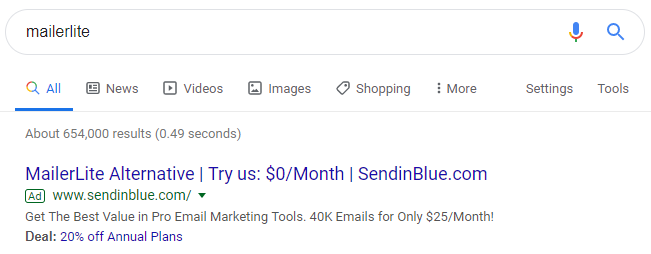
Image: wordstream.com
If you do this, just make sure you’re not being offensive or obnoxious. No one likes that 🙂
Strategy 4: Social Media Advertising
Facebook, Instagram, LinkedIn, TikTok, Twitter… None of these companies would be nearly as big if it weren’t for their advertising systems that work incredibly well.
So much so that organic social media, and especially for newly established companies, is actually less cost-effective for companies.
These social platforms offer a slew of targeting options so that you can make your ads reach the right people, likely to convert into leads and later customers.
Promote valuable content on social media, even when it’s ungated like case studies, and make sure you optimize your ads regularly to avoid ad fatigue.
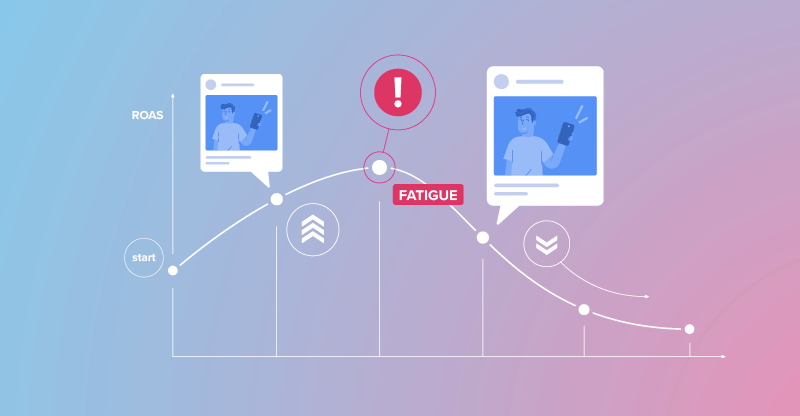
Image: madgicx.com
Sometimes, it takes hundreds of impressions from one person before they actually click on one of your ads.
Strategy 5: Traditional Media Advertising
The dinosaurs of the advertising space: TV, radio, print, and billboards are far from dead.
Sure, they usually do require a larger marketing investment than digital advertising, but they should also bring in bigger results, especially as far as brand awareness.
Of course, depending on your industry or business model, they may not make sense. And if that’s the case, just skip on over to the next B2B outbound marketing strategy.
On the other hand, if you’re doing business locally or only in a certain region, with a target audience that consumes content from these media, traditional media advertising may be well worth your budget.
Strategy 6: Trade Shows and Events
Trade shows and events may very well be one of the most interesting ways to employ B2B outbound marketing.
It’s interesting talking to people in person, and easier to connect might I add, especially today where we’re all digital. You now actually get to put a real face to a name.
However, these events will typically require higher investments on your part, especially if you plan on having a stand.
It’s why it’s crucial that you set concrete and realistic marketing goals, and budget accordingly.
Otherwise, you risk being overwhelmed, and without a goal, you could get lost in it all, ultimately having fun but not making any return on your marketing investment.
Pro tip: Create a giveaway at your stand. That way, people will be incentivized to leave their business cards and you’ll be walking away with a bunch of new leads who already have brand awareness.
Strategy 7: Direct Mail Campaigns
Direct mail is a great way to grab attention and stand out in the digital world!
While it may seem outdated, you have to admit, we still enjoy getting a package with our name on it, whether one we’ve ordered ourselves or a gift (just please don’t let it be another bill 🤞).
Curate a gift box relevant to your target audience, include a way for them to get in touch with you, and you’ll be good to go. And trust us, it works!
A few years ago, the internet was in awe of a young marketer who used this strategy to land job interviews.
Knowing that it’s going to be super difficult to stand out in the San Francisco tech scene, he opted to deliver his CV in a different way.
He disguised himself as a delivery man and delivered a box of doughnuts to companies. Thanks to this, he landed 10 interviews with this tactic.
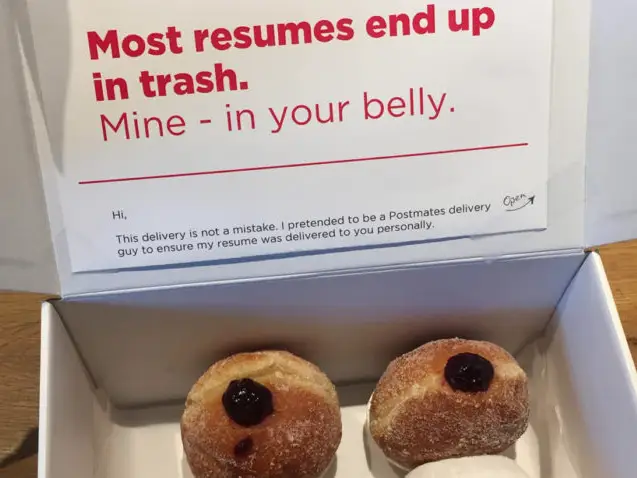
Image: Reddit
Don’t be afraid to get creative, especially when it comes to marketing and sales, it could do wonders for your business!
Strategy 8: Sponsorships
A sponsorship is a great way to increase brand awareness, as long as you target the right event for your prospective customers, including conferences, fundraisers, festivals, etc.
Along with exposure to your prospective clients, you’ll also get increased brand credibility and positive association with your brand. When you associate yourself with well-known organizations, you’ll be aligning your brand with their trustworthiness and values.
When you later contact some of the prospective customers you meet, they’ll likely at least have heard about your company.
Finally, sponsoring an event and participating in it is a great networking opportunity to meet new leads.
Strategy 9: Public relations
Creating a press release that stands out enough to get media coverage is one of the most difficult things you’ll find on this B2B outbound marketing strategies list. That being said, it’s in no way impossible.
We’ve prepared some general tips to hold onto:
👉 Unless you have connections in the media, think of your target audience when you write. Create something that they will relate to, that will resonate with them. Use the language they understand to address the pain points they have.
👉 Distribution-wise, it’s always much better to send your release to fewer addresses but highly relevant ones. Ten thousand relevant eyes are much better than 1 million irrelevant eyes.
👉 If you’re not a good storyteller, find someone who is, and don’t be afraid to share who you are, where your values lay, and what your vision is.
👉 Study newsjacking! It’s one of the best ways to actually get picked up by the media.

Image: hubspot.com
Remember the 2013 Superbowl?
During the short power outage, Oreo reacted super fast and posted the above visual that had blown up on the internet, in one of the best recent instances of newsjacking.
Strategy 10: LinkedIn InMail
While it technically belongs to social media advertising, LinkedIn InMail deserves its own section.
Unless you’re connected to someone on LinkedIn, you have no way of sending them a message.
That’s where the paid LinkedIn InMail comes in.
Better yet, you can use LinkedIn’s rich targeting options to send InMail messages to all users who fit the criteria that you set — and on this platform, that goes as far as job role, years of experience, etc.
As far as concrete tips, you can think of them similarly to the way you think of cold emails.
👉 Make sure your subject line is intriguing enough without appearing spammy or sensationalist.
👉 Personalize the message as best as you can, and ensure it is actually relevant to the person.
👉 Have a clear goal of the InMail and display a clear and prominent call-to-action.
👉 Try to keep it as short as possible. As the character count goes up, the response rate decreases.
If you are looking for more in-depth tips, check out our In-Depth Guide on How to Cold Outreach on LinkedIn.
Strategy 11: Retargeting Ads
In the land of online advertising, retargeting ads are the most cost-effective solution with the cost per action usually lower and higher conversions.
This is because you’ll be retargeting potential customers who already know about your business, so they don’t need as much convincing.
The marketing content you remarket to them should typically be bottom-of-the-funnel content, and you shouldn’t be afraid to talk to them like you know them, many people appreciate this type of sassiness from brands.
Show them products they had already viewed, use urgency to push them to action or offer theme small discounts. Maybe it’s just that little push they need to convert!
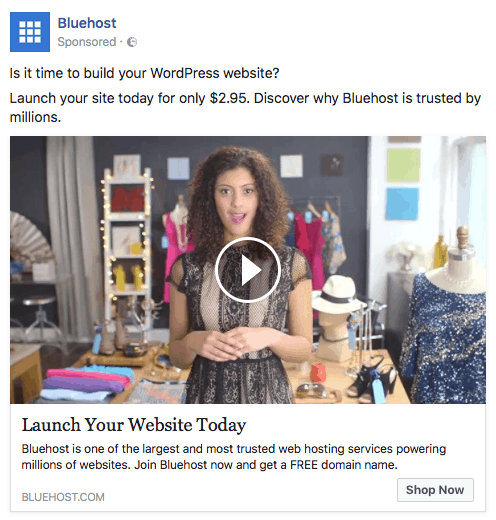
Image: directconsulting.com
Is now the right time to purchase our product? 😉
Strategy 12: SMS Marketing
SMS marketing can be a great B2B outbound marketing strategy, as long as you make it personalized enough, ensure that you have permission, and provide an easy way for potential customers to unsubscribe.
It’s a strategy that provides immediate and direct reach to your potential customers, as well as high open rates that could lead to higher sales.
Be sure to mind your frequency and timing, especially if you operate in a variety of regions. Moreover, consult the laws and regulations of each region you operate in to confirm that what you plan to do is permissible by law.
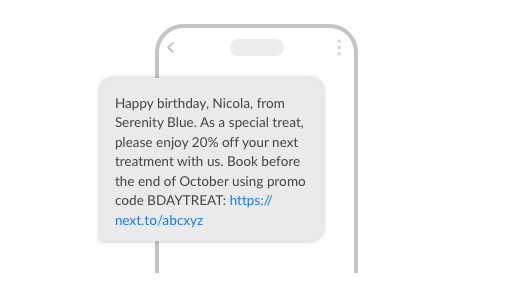
Image: messagemedia.com
SMS marketing allows for quick and personalized messages to your potential customers that can get quick results, such as the one in the image above.
Tips Before You Start
Ah… careful planning, otherwise known as the final ingredient you need for your B2B outbound marketing strategy to succeed.
We’d argue that planning is 50% of the work that sets you up for success, so read up.
Tip 1. Define your Ideal Customer Profile (ICP)
Before you do anything marketing-wise, define your Ideal Customer Profile (ICP). Otherwise, you’ll just be shooting in the dark.
An ICP will help you laser-focus your efforts on a market that actually needs your product or service, thereby increasing your chances of closing sales. Additionally, it enables you to personalize your communications to see a higher return on your investment.
Usually, your ICP will include details like who your customers are, what they’re interested in, their goals and pain points, and their buying decision process.
To find these, take a look at your best customers and identify the things they have in common. Most importantly, don’t feel too much pressure to get everything right. An ICP is meant to be tweaked along the way as you gain more experience.
If you don’t yet have any customers, make a hypothesis on your best customers. Then go out, test it out, and tweak your ideal customer profile.
Tip 2: Create a List of High-Quality Leads
Keep your ICP handy, head to LinkedIn (or any alternative business database you may be using), and plug in the details into search filters.
You’re then free to go through the Search results and test out the strategies named above.
If you need the prospect’s email address or phone number, consider using an email-finding tool such as ZeroIn.
You can install ZeroIn as a browser extension, and then match an individual LinkedIn profile or search results page in bulk with data from its 200M database that includes email addresses and phone numbers among other data points.
Moreover, these emails and phone numbers are verified so that you can create truly high-quality B2B lead lists.
Tip 3: Use a Light CRM at the Beginning
Don’t forget to start using a CRM tool — to avoid forgetting valuable prospect details.
CRM tools let you easily keep track of your leads, their current status, your communications, and interactions, and even let you set up reminders for follow-ups. Don’t let any high-quality leads go to waste!
If you do decide to use the ZeroIn email finder mentioned above, you’ll be happy to know that it comes with a lightweight CMR tool, perfect for a starter B2B outbound marketing strategy.
Tip 4: Create an Irresistible Offer
What are you offering? Or what’s best that you can offer?
Make financial projects, find the best possible offer that you can sell at without losing money, and phrase it well. An irresistible offer will compel prospects to take action and engage with your business, especially if it’s time-limited 😉
Conclusion
There you have it — our proven B2B outbound marketing strategies are sure to help you meet your sales targets as fast as possible.
Not every single one will work for you, but many will. You just have to start testing.
Want our advice? Start with cold emailing, the staple of each outbound strategy for B2B companies.
What is ZeroIn?
Introducing ZeroIn: an all-in-one email discovery solution, complete with a streamlined CRM for effortless organization and management of valuable prospect data. Beyond essential contact details like business emails and phone numbers, ZeroIn uncovers over 20 additional insights related to your contacts and their companies.
Effortlessly integrated with your Free or Sales Navigator LinkedIn searches, ZeroIn empowers your outreach through a browser extension that applies your search criteria and harnesses its vast database to present a complete picture of your potential clients.
ZeroIn goes beyond the ordinary by delivering up to 26 unique data points, including verified business emails, outshining conventional data such as phone numbers and email addresses. Our exclusive 10-step verification process guarantees the accuracy and legitimacy of every email address you encounter.
Moreover, ZeroIn enables you to import and re-verify existing email lists, and conveniently export leads in versatile formats like CSV, XLS, and Google Drive.
For those times when you need a quick assessment, ZeroIn’s “single email verification” feature offers rapid, reliable checks on individual email addresses. Elevate your prospecting game with ZeroIn – the ultimate tool for email discovery and management.
How can ZeroIn help your business?
ZeroIn helps you boost your outreach and sales by streamlining prospect list building. You can find and verify prospect email addresses in a click, both individually and in bulk while keeping your CRM data clean through the duplicate finder.
Because it offers a lifetime, pay once, and use forever deal, ZeroIn is ideal for SMBs in the growth stage.
Create a Free Account and Get 25 credits!
What is Outbound Marketing Strategy for B2B?
An Outbound Marketing Strategy for B2B companies is the process of proactively contacting prospective customers without having any prior relationship. Outbound channels include cold emailing, cold calling, advertising, and more.
Difference between Inbound and Outbound Marketing Strategy for B2B?
Outbound marketing is proactive outreach from your side to potential customers with whom you have no prior interaction. On the other hand, inbound is all about passively and organically attracting customers by providing high-quality content.
You’ll likely need both. Outbound is great for getting quick results while inbound is more cost-effective in the long term.
Which B2B Outbound Marketing Strategies Work?
Some of the B2B Outbound Marketing strategies that you can start testing today include cold emailing, cold calling, paid search ads, paid social ads, retargeting ads, and LinkedIn InMail, among others.
